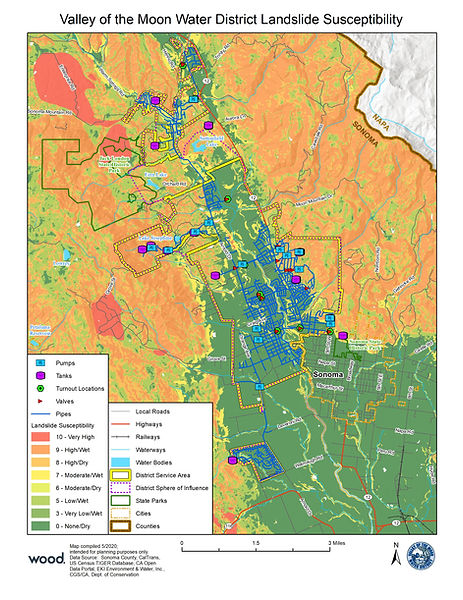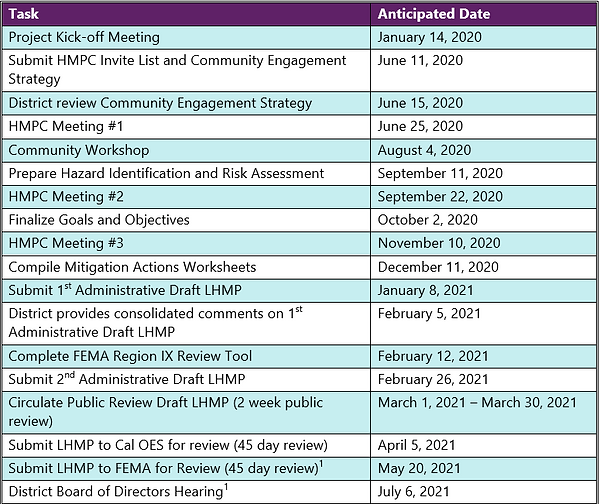It is the mission of the Valley of the Moon Water District to provide its customers with
reliable, safe water at an equitable price, and to ensure the fiscal and
environmental vitality of the District for future generations.
customerservice@vomwd.org
707.996.1037
Mon. - Thurs. 8 to 5 / Fri. 8 to 4
Closed for Lunch: 12 - 12:30 (on-call 24/7)
Phone Payments: 1-833-360-7525
Local Hazard Mitigation Planning
Thanks to a grant from FEMA, the Valley of the Moon Water District (District) has started the preparation of their first Local Hazard Mitigation Plan (LHMP) and we invite the community to participate in the planning process. The LHMP will serve as a blueprint for reducing property damage and saving lives from the effects of future natural and human-caused disasters in the District’ s service area. To guide this planning process, the District has established two groups that will make up a Hazard Mitigation Planning Committee (HMPC): the Stakeholder Committee who will work most closely to develop the plan; and the Working Group who will provide broad perspective during plan development.

What is Hazard Mitigation?
The Federal Emergency Management Agency (FEMA) defines hazard mitigation as, “any sustained action taken to reduce or eliminate long-term risk to life and property from natural hazards.” Another way to understand hazard mitigation is the prevention component of the emergency management process.
Hazard mitigation is the first step in the disaster cycle and it is followed by preparedness, response, and recovery.
· Preparedness activities include emergency plans, training, drills, and exercises that individuals, communities and first responders participate in on almost daily basis. These are things done to get ready for an emergency or disaster before it happens.
● Response is the short-term, emergency actions taken to address the immediate impacts of a hazard.
● Recovery is the longer-term process of restoring the community back to normal or pre-disaster conditions.
● Mitigation activities are cost-effective actions that will reduce or eliminate impacts, for anticipated future events. Mitigation can reduce or eliminate the need for an emergency response and greatly reduce the recovery period.
Many types of mitigation actions are things done on a daily basis without much forethought such as purchasing insurance to protect a home investment, putting on your seatbelt, or putting in gutters around a roof to better direct rain runoff. The same concepts apply to community level hazard mitigation planning. Mitigation planning is a process for county, city, and local governments or special districts to identify community-level policies and actions that will reduce the impacts of natural hazards.


Why is Hazard Mitigation Important?
Most people who live or work in the Valley of the Moon Water District service area have been affected by hazards in one way or another. Some of the hazards that can affect the District include earthquakes, flooding, wildfire, drought, high winds, electrical power shutoffs, and severe weather. Sonoma Valley has a long history of persistent flooding and the region has experienced recent and large-scale wildfire impacts from the Nuns Fire. In addition to these large events, there are also smaller, isolated weather events that cause localized property damage and losses significant to the people and infrastructure affected. While these natural hazards cannot be prevented, the development of a Local Hazard Mitigation Plan (LHMP) will evaluate the potential for future damaging events and work toward long-term solutions and strategies to help mitigate their impacts in the future. This long-term strategy also reduces future disaster losses by breaking the repeated cycle of disaster damage and reconstruction. According to a report by the National Institute of Building Sciences, it is estimated that for every one dollar invested in hazard mitigation, an average of six dollars is saved on long-term disaster response and recovery.
Hazard mitigation plans are also required by law in order for municipalities to be eligible to apply for and receive Federal Emergency Management Agency (FEMA) hazard mitigation funds. The Robert T. Stafford Disaster Relief and Emergency Assistance Act (Stafford Act) was signed into law in 1988 and provides the authority for federal disaster assistance activities, including preparedness and mitigation along with assistance for response and recovery.
The Disaster Mitigation Act of 2000 (DMA 2000) amended the Stafford Act to reinforce the importance of mitigation planning and emphasize planning for disasters before they occur. DMA 2000 also established provisions and requirements for state, local, special districts, and Indian Tribal entities to closely coordinate mitigation planning and implementation efforts.


Plan Development Process
The Valley of the Moon Water District is taking the lead on the preparation of their first LHMP in accordance with the DMA 2000 and with professional planning assistance from Wood Environment and Infrastructure Solutions, Inc. (Wood). The purpose of the LHMP development process is to help reduce the impacts of natural hazards to the District and the community it serves. Wood will facilitate the planning process, collect necessary natural hazard data, and perform other technical services, including preparing the risk assessment and LHMP document.
A planning team, referred to as a Hazard Mitigation Planning Committee (HMPC) will be organized, and will meet on a regular basis, working through varying levels of review, and revision of the following elements of the LHMP:
● Identify hazards that may impact or have impacted the District;
● Profiles of hazard events;
● Assessment of the vulnerability to those hazards;
● Assessment of the District’s capabilities to mitigate the hazards;
● Mitigation goals;
● Specific mitigation actions and projects;
● Implementation strategy for the plan;
● Plan maintenance and update process;
● Plan approval and adoption.
The HMPC will include staff representatives and board members from the Valley of the Moon Water District. Stakeholders on the planning team will include representatives from federal and state agencies, and local municipalities, organizations, educational institutions, and businesses.
The planning process began with a kick-off for the first HMPC meeting in June 2020. A public workshop will be scheduled in August 2020. The second HMPC meeting will be scheduled in September 2020 and the third HMPC meeting will be scheduled in November 2020. The LHMP will be developed in early 2021, with a draft for public review anticipated by March 2021.


How Can you Get Involved?
Members of the public have a very important role in this process. The planning team regards broad public participation in the planning process as an essential strategy for developing a plan that will be effective, supported by residents within the District, and ultimately implemented. The process will provide a range of opportunities for the District and its customers, public officials, and stakeholder groups to participate and provide input on the development of the plan. Interested stakeholders should pay attention to the Valley of the Moon Water District’s LHMP webpage at https://www.vomwd.org/local-hazard-mitigation for updates on the process and availability of the Public Review Draft LHMP.
For more information on the Valley of the Moon Water District’s LHMP or the planning process, please contact:
Valley of the Moon Water District
Amanda Hudson
Administration Finance Manager
19039 Bay Street
P.O. Box 280
El Verano, CA 95433
Phone: (707) 996-1037
Wood Environment and Infrastructure Solutions, Inc.
Juliana Prosperi, AICP
Project Manager
10940 White Rock Road, Suite 190
Rancho Cordova, CA 95670
Phone: (303) 503-7794


This schedule is based on planning HMPC Meeting #1 as a Zoom Webinar rather than an in-person meeting based on the COVID-19 shelter-in-place order. The GIS data sets were received in January and Wood’s team prepared maps for key priority hazards, including earthquakes, flooding, and wildfires. The planning process will be contingent on HMPC participation, meeting attendance, and timely inputs on the planning worksheets and Draft LHMP document.




